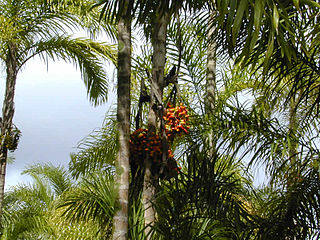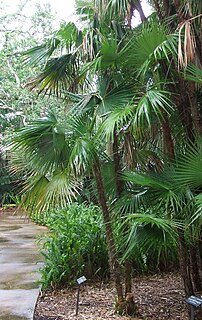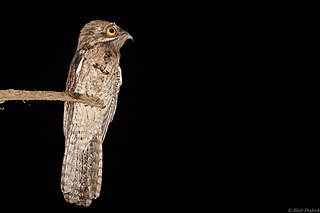
Bactris is a genus of spiny palms which are native to Mexico, South and Central America and the Caribbean. Most species are small trees about 2 m tall, but some are large trees while others are shrubs with subterranean stems. They have simple or pinnately compound leaves and yellow, orange, red or purple-black fruit. The genus is most closely related to several other spiny palms—Acrocomia, Aiphanes, Astrocaryum and Desmoncus. The fruit of several species is edible, most notably B. gasipaes, while others are used medicinally or for construction.

Aiphanes is a genus of spiny palms which is native to tropical regions of South and Central America and the Caribbean. There are about 26 species in the genus, ranging in size from understorey shrubs with subterranean stems to subcanopy trees as tall as 20 metres (66 ft). Most have pinnately compound leaves ; one species has entire leaves. Stems, leaves and sometimes even the fruit are covered with spines. Plants flower repeatedly over the course of their lifespan and have separate male and female flowers, although these are borne together on the same inflorescence. Although records of pollinators are limited, most species appear to be pollinated by insects. The fruit are eaten by several birds and mammals, including at least two species of amazon parrots.

Roystonea is a genus of eleven species of monoecious palms, native to the Caribbean Islands, and the adjacent coasts of the United States (Florida), Central America and northern South America. Commonly known as the royal palms, the genus was named after Roy Stone, a U.S. Army engineer. It contains some of the most recognizable and commonly cultivated palms in tropical and subtropical regions.

The Cuban macaw or Cuban red macaw is an extinct species of macaw native to the main island of Cuba and the nearby Isla de la Juventud. It became extinct in the late 19th century. Its relationship with other macaws in its genus was long uncertain, but it was thought to have been closely related to the scarlet macaw, which has some similarities in appearance. It may also have been closely related, or identical, to the hypothetical Jamaican red macaw. A 2018 DNA study found that it was the sister species of two red and two green species of extant macaws.

The Greater Antillean grackle is a grackle found throughout the Greater Antilles as well as smaller, nearby islands. Like all Quiscalus grackles, it is a rather large, gregarious bird. It lives largely in heavily settled areas. It is also known as the 'kling-kling' and 'chinchilín' in the Dominican Republic, as a 'Ching Ching' in the Cayman Island and as a ‘chango’ in Puerto Rico.

Aiphanes minima is a spiny palm tree which is native to the insular Caribbean from Hispaniola to Grenada, and widely cultivated elsewhere. Usually 5–8 metres (16–26 ft) tall, it sometimes grows as an understorey tree and only 2 m (6.6 ft) in height.
Bactris cubensis is a species of palm endemic to the Nipe-Baracoa Massif and eastern Sierra Maestra in eastern Cuba at elevations between 40 and 700 metres above sea level. B. cubensis trees grow 2.7 to 6.4 m tall in clumps of 6 to 12 stems.
Bactris plumeriana is a species of palm endemic to Hispaniola.
Bactris campestris is a small spiny palm which grows in multi-stemmed clumps in savannas and low forests in northern South America from Colombia to the Guianas, Trinidad and Tobago, and northern Brazil.

Bactris setulosa is a medium-sized spiny palm which is found in Colombia, Venezuela, Ecuador, Peru, Trinidad and Tobago and Suriname. It is one of the largest species of Bactris and is found at the highest elevations.
Calyptronoma plumeriana is a pinnately compound leaved palm species which is native to Cuba and Hispaniola.

The Antillean palm swift is a small swift. It has distinctive black-and-white markings on its underparts, rump, and throat, making it one of the most unmistakable species of swifts in North America.

Zombia antillarum, commonly known as the zombie palm, is a species of palm tree and the only member of the genus Zombia. It is endemic to the island of Hispaniola in the Greater Antilles. Usually found in dry, hilly areas of northern and southern Haiti and the northwest of the Dominican Republic, Z. antillarum is a relatively short fan palm with clustered stems and a very distinctive appearance caused by its persistent spiny leaf sheaths. Threatened by habitat destruction in Haiti, Z. antillarum is a popular ornamental species due to its distinctive appearance, low maintenance requirements and salt tolerance.
This is a list of plants which includes trees and other herbs, vines, climbers, lianas, shrubs, subshrubs that are native or endemic, found in Cuba.

The northern potoo is a nocturnal bird belonging to the potoo family, Nyctibiidae. It is found from Mexico south to Costa Rica, and on the islands of Jamaica and Hispaniola. It was formerly classified as a subspecies of the common potoo but is now usually treated as a separate species based on differences in vocalizations.
The Caribbean bioregion is a biogeographic region that includes the islands of the Caribbean Sea and nearby Atlantic islands, which share a fauna, flora and mycobiota distinct from surrounding bioregions.
Coccothrinax jamaicensis, the silver thatch or Jamaican silver thatch, is a fan palm believed to be endemic to Jamaica. A slender palm growing up to 8 metres (26 ft) tall, it grows in coastal areas on limestone or sand.
The Hispaniola monkey is an extinct primate that was endemic on the island of Hispaniola, in the present-day Dominican Republic. The species is thought to have gone extinct around the 16th century. The exact timing and cause of the extinction are unclear, but it is likely related to the settlement of Hispaniola by Europeans after 1492.

The Cuban moist forests is a tropical moist broadleaf forest ecoregion that occupies 21,400 km2 on Cuba and Isla de la Juventud. The ecoregion receives more than 2,000 mm (79 in) of rainfall annually, and does not have a dry season. Soils are usually derived from quartz, limestone, or serpentinites. Cuban moist forests can be differentiated into lowland forests, sub-montane forests, and montane forests.











